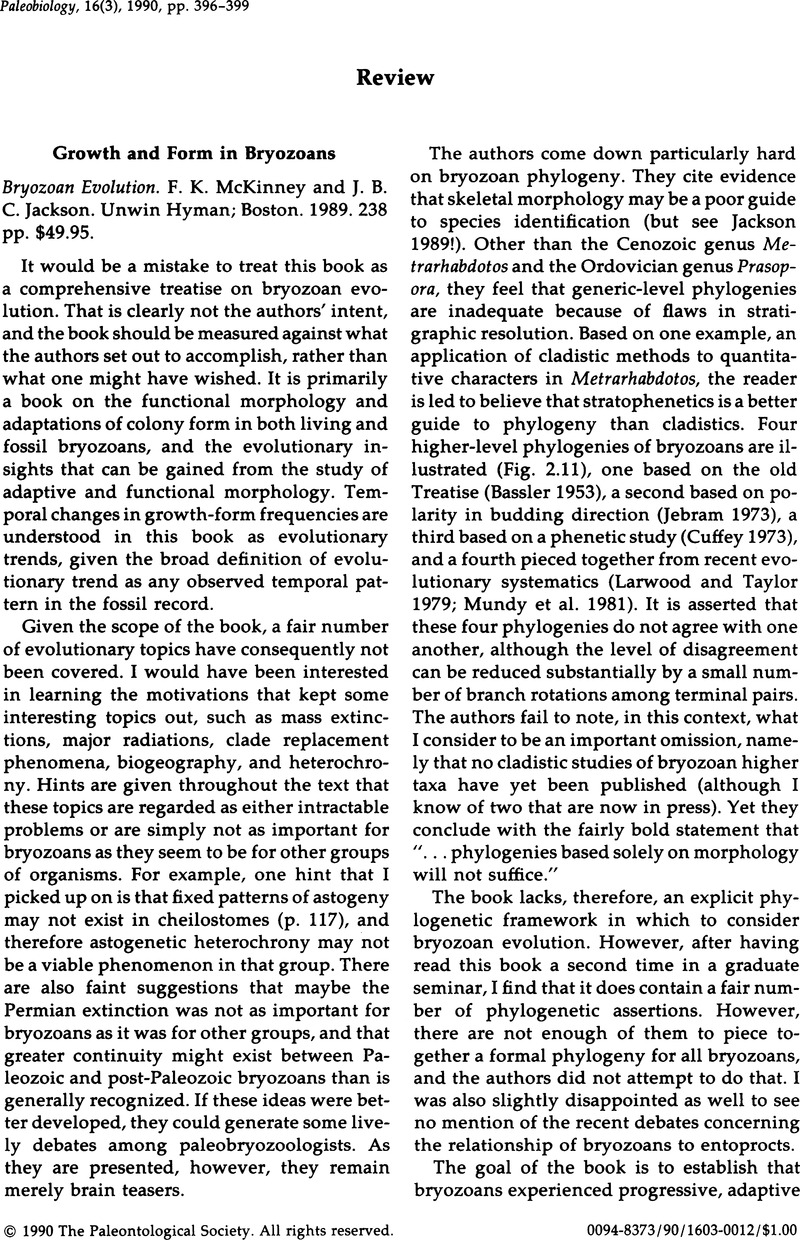No CrossRef data available.
Article contents
Growth and Form in Bryozoans - Bryozoan Evolution. F. K. McKinney and J. B. C. Jackson Unwin Hyman; Boston. 1989. 238 pp. $49.95.
Published online by Cambridge University Press: 08 April 2016
Abstract
An abstract is not available for this content so a preview has been provided. Please use the Get access link above for information on how to access this content.

- Type
- Reviews
- Information
- Copyright
- Copyright © The Paleontological Society
References
Literature Cited
Anstey, R. L. 1987. Astogeny and phylogeny: evolutionary heterochrony in Paleozoic bryozoans. Paleobiology 13:20–43.Google Scholar
Anstey, R. L. 1989. Major radiation-extinction bounded packages of Paleozoic bryozoans: significance of the post-Ordovician faunal break. Geological Society of America, Abstracts with Programs 21:A209.Google Scholar
Bassler, R. S. 1953. Bryozoa. Pp. 1–253. In Moore, R. C. (ed.), Treatise on Invertebrate Paleontology, Part G. Geological Society of America; New York, and University of Kansas; Lawrence.Google Scholar
Cuffey, R. J. 1973. An improved classification, based upon numerical-taxonomic analyses, for the higher taxa of entoproct and ectoproct bryozoans. Pp. 549–564. In Larwood, G. P. (ed.), Living and Fossil Bryozoa. Academic Press; London.Google Scholar
Dzik, J. 1975. The origin and early phylogeny of the cheilostomatous Bryozoa. Acta Palaeontologica Polonica 20:395–423.Google Scholar
Gould, S. J. 1988. Trends as changes in variance: a new slant on progress and directionality in evolution. Journal of Paleontology 62:319–329.Google Scholar
Gould, S. J., and Lewontin, R. C. 1979. The spandrels of San Marco and the Panglossian paradigm: a critique of the adaptationist programme. Proceedings of the Royal Society of London B 205:581–598.Google Scholar
Harmelin, J.-G. 1975. Relations entre la forme zoariale et l'habitat chez les bryozoaires cyclostomes. Conséquences taxonomiques. Documents des Laboratoires de Géologie de la Faculté des Sciences de Lyon, hors-série 3:369–384.Google Scholar
Jackson, J. B. C. 1989. Are skeletons enough to tell species apart? A test using cheilostome Bryozoa. Geological Society of America, Abstracts with Programs 21:A289.Google Scholar
Jebram, D. 1973. The importance of different growth directions in the Phylactolaemata and Gymnolaemata for reconstructing the phylogeny of the Bryozoa. Pp. 565–576. In Larwood, G. P. (ed.), Living and Fossil Bryozoa. Academic Press; London.Google Scholar
Larwood, G. P., and Taylor, P. D. 1979. Early structural and ecological diversification in the Bryozoa. Pp. 209–234. In House, M. R. (ed.), The Origin of the Major Invertebrate Groups. Academic Press; London.Google Scholar
Mundy, S. P., Taylor, P. D., and Thorpe, J. P. 1981. A reinter-pretation of phylactolaemate phylogeny. Pp. 185–190. In Larwood, G. P., and Nielsen, C. (eds.), Recent and Fossil Bryozoa. Olsen and Olsen; Fredensborg, Denmark.Google Scholar
Sandberg, P. A. 1983. Ultrastructure and skeletal development in cheilostomate Bryozoa. Pp. 238–286. In Robison, R. A. (ed.), Treatise on Invertebrate Paleontology, Part G, Bryozoa Revised, Volume 1. Geological Society of America; Boulder, Colorado, and University of Kansas; Lawrence.Google Scholar
Stach, L. W. 1936. Correlation of zoarial form with habitat. Journal of Geology 44:60–65.Google Scholar
Taylor, P. D. 1981. Functional morphology and evolutionary significance of differing modes of tentacle eversion in marine bryozoans. Pp. 235–247. In Larwood, G. P., and Nielsen, C. (eds.), Recent and Fossil Bryozoa. Olsen and Olsen; Fredensborg, Denmark.Google Scholar
Winston, J. E. 1976. Experimental culture of the estuarine ectoproct Conopeum tenuissimum from Chesapeake Bay. Biological Bulletin 150:318–335.Google Scholar


